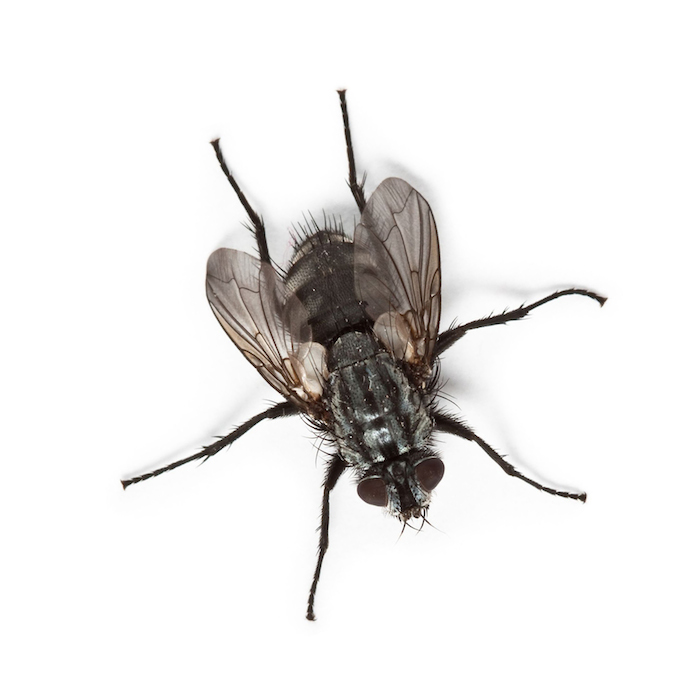Bill Foss and black soldier fly larvae to the rescue!
Talking to Bill Foss, even while he’s driving, means discussing black soldier flies and the protein values of larvae and pupae; fitting the word “detritivore” into a sentence; considering an extrusion machine that can produce insect pellets as easily as it can Cheetos; discovering that a commercially-bred chicken is tantamount to a diet soda in nutritional value; nodding in sympathy over the dysfunction of Sonoma County government; and learning a lot about omega-3
and omega-6 compounds.
And that’s before he sends a photo of a typical farmed fish diet label and a copy of the American Pastured Poultry Producers Association newsletter to my spam filter.
To say that Foss is engaged in his work would be to understate it. The man is raging. Fortunately, he’s on our side.
And when it comes to food, he knows his stuff. With partner Kenny Belov, Foss co-owns TwoXSea, a sustainable fish provider based on San Francisco’s Embarcadero. The two also co-own the suitably named FISH restaurant in Sausalito. With rancher David McFarland, the partners run McFarland Springs Trout Farm near Susanville. Foss additionally has a major interest in such excellent Sonoma County eateries as the Kenwood Restaurant in the Sonoma Valley and the Canneti Roadhouse Italiana in Forestville. A recent visit to the Kenwood found the notation “F/V” on the daily menu, next to a seafood dish. Ah, the server smiled. “Fishing vessel,” he clarified. Yes, Bill Foss’ restaurant will tell you which ship caught your dinner.
A co-founder of Netscape, Foss recently purchased the former Hatchery in Penngrove intending to launch a food start-up incubator in the place. Cue mention of Sonoma County governmental dysfunction. Looks like he’ll probably take his ideas to Yolo County instead.
But the real purpose of our talks is so that Foss can explicate a new idea he’s investigating around food waste. It’s a just-in-time notion as the AB1826 legislation requiring food waste diversion from landfills comes to maturation in California in tandem with Sonoma County saying a final goodbye to our local composter. It’s a clever sidestep of the soy and corn, poultry fat and fish by-products fed to commercial livestock. And some might suggest that it has a significant ick factor.
Of course, we’re back to black soldier flies. Not to be confused with houseflies, black soldier flies are slow and easy to catch. They don’t bite. They’re not even considered a pest. What they do like to do is to eat composting materials, leave their fat juicy larvae upon them, let their mouths metamorphose into climbing implements, and die. Black soldier fly larvae are already in such use as a composting aid that they have their own BSFL acronym. Foss is betting that this could become a household phrase.
Enormously high in protein, BSFL have a real opportunity to replace the unnatural and health-damaging substances that commercial producers feed pigs and chickens and be an ideal food for the farmed trout Foss helps to raise in Susanville.
The irony that AB1826, the bill sponsored in part by Santa Rosa’s own assembly member Wes Chesboro, began to take effect this July just as our local composting facility was being forcibly closed, makes the timing even better.
AB1826 means to reduce our landfills by mandating that businesses of a certain size—like grocery stores and large restaurants—divert their food waste elsewhere. By the time the law is in full effect in 2019, it will impact all producers who create 100 tons or more of commercial waste per year. They’re going to need some way to compost or anaerobically digest it with or without the aid of the Sonoma Compost facility. Once again, enter BSFL.
The fly larvae plan goes back to natural processes. The larvae help to break down the waste while making themselves all the yummier and more nutritious. They, in turn, are harvested and turned into pellets (this is the machine that can also produce Cheetos) and can be fed to livestock—as well as fish, which are normally and horrendously fed . . . fish.
“If you’re farming chickens and pigs and fish and not using fish meal and fish oil, you’re using corn and soy as a protein replacement,” Foss says, navigating the potholes on Slusser Road. “If you are using fish, you’re putting mercury into the food. Meanwhile, omega-6 is a leading cause of diabetes and cancer in the U.S. You can use organic soy and still generate a chicken that’s so loaded with omega-6 that’s it’s as good for you as a Diet Coke.”
BSFL invert the omega-3/omega-6 paradigm that doctors and nutritionists follow, offering more good (omega-3) and less bad (-6) to the diet. Foss and his partners have launched the scheme and are taking technical advice from the University of Hawaii. Even though frustrated by local government, he’s still interested in making this effort available to local producers.
“If we can take food waste and throw it into this system and bring it to the farm, the farmers themselves can convert the food waste into these flies and our local small farmers will have a better solution than corn or soy at half the price, which allows them to compete against the big guys, like Petaluma Poultry who are doing factory farming and calling it ‘free range,’” Foss says.
Irritated, engaged, thoughtful, forward-looking, impatient—Foss raises his voice as the cell phone hits a muted spot. “We’re helping the county with a law they’re not prepared for, we’re helping with food waste—we throw away 40 percent of our food—we’re converting it to feed that’s nutritionally superior to what a farmer can buy now, and hopefully we’re doing it at a price that beats the corn-based solution.”
But really, the ick factor?
“The flies don’t have a flavor by themselves,” he assures. “They’re just protein.”

